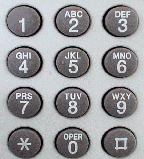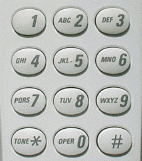 | |||||||||||||||||
|
Contents
| |||||||||||||||||
| |||||||||||||||||
|
| |||||
Where it all Started
Back in the old days, the first two numbers of a phone number would indicate the exchange (actually, the "central office"). The caller would ask the operator to connect them to something like "klondike-442", where the real phone number would be 55442, with both the "K" and "L" filling in for a 5 each. See the Telephone Exchange Name Project for the whole story. Here is how the numbers are associated with letters:
2 ABC 6 MNO 3 DEF 7 PRS 4 GHI 8 TUV 5 JKL 9 WXY If you look closely, you will see that it neither covers all numbers, nor does it mention all letters. Something Useful for 1 and 0Officially, the numbers 1 and 0 did not map to anything on the phone pad. This is because 1's and 0's used to be reserved for area codes. The middle digit in an area code was always a 0 or a 1, and these two number could not appear anywhere else in the area code so that the equipment used to route phone connections could easily recognize area codes. Even though these restrictions have long been lifted, none of todays phone key pads (except for some European ones) associate the number 1 with any letters. The UK phone key is the only one to map letters to the number 0. Still, some vanity numbers in the US, for instance, incorporate the numbers 0 and 1 the same way some vanity license plates incorprate digits. What about "Q" and "Z"
The letters "Q" and "Z" have no numbers associated with them on most older phone pads, but on many recent key pads, espicially on cell phones, they are mapped to numbers. There are actually many different types of key pads. Different countries have different standards, but it is not uncommon to find different types of key pads within the same country. Certain scandinavian telephone key pads even find places for those local funky looking squiggly characters. However, most phone manufactured today use the international standard ITU E 1.161, also known as ANSI T1.703-1995/1999 and ISO/IEC 9995-8:1994). It assigns PQRS to 7 and WXYZ to 9. | |||||

